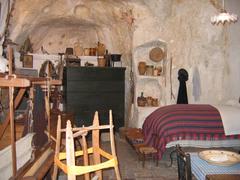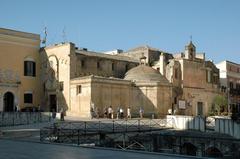Madonna della Virtù e San Nicola dei Greci: Complete Visiting Guide, History, and Ticket Information
Date: 14/06/2025
Introduction
Nestled in the ancient Sassi districts of Matera, the rupestrian complex of Madonna della Virtù and San Nicola dei Greci stands as a unique testament to centuries of religious devotion, artistic innovation, and cultural exchange in southern Italy. Carved directly from the soft calcarenite rock that defines Matera’s landscape, this extraordinary site invites visitors on a journey through medieval monastic life and Byzantine art, reflecting the city’s role as a crossroads between Eastern and Western Christian traditions (Matera Welcome; Guide Matera).
Today, travelers can explore two main rock-hewn churches—Madonna della Virtù (lower level) and San Nicola dei Greci (upper level)—linked by a labyrinth of monastic cells and passageways. The site’s preserved Byzantine frescoes and medieval architecture, combined with its function as a venue for contemporary art exhibitions, make it a must-visit for anyone seeking to understand Matera’s layered history and vibrant cultural scene (Sassi di Matera; Lonely Planet).
Contents
- Historical Overview
- Origins and Early Development
- Architectural Evolution and Artistic Influences
- Restoration and Adaptive Reuse
- Religious and Cultural Significance
- Visitor Information
- Visiting Hours
- Tickets and Admission
- Accessibility
- Guided Tours and Travel Tips
- Nearby Attractions
- Artistic and Iconographic Highlights
- Notable Frescoes
- Contemporary Art Exhibitions
- Heritage Preservation and Community Engagement
- Frequently Asked Questions (FAQ)
- Visual and Media Suggestions
- Conclusion and Visitor Recommendations
- Sources and Further Reading
Historical Overview
Origins and Early Development
The Madonna della Virtù and San Nicola dei Greci complex traces its roots to the 9th and 10th centuries, when monastic communities fleeing persecution in the eastern Mediterranean settled in Matera. These monks brought Byzantine liturgical rites and artistic traditions, carving sanctuaries and communal spaces directly into the rock (Cultural Heritage Online). The site evolved as a hub for both religious practice and cultural exchange, blending Eastern and Western Christian influences.
Architectural Evolution and Artistic Influences
The complex is organized vertically within the cliff face:
- Lower Level – Madonna della Virtù: Features Romanesque architecture with rounded arches and barrel vaults, reflecting Western liturgical design.
- Upper Level – San Nicola dei Greci: Showcases strong Byzantine influences in both structure and decoration, including two naves and iconographic frescoes.
Around these churches, a network of monastic cells, storerooms, and communal spaces exemplifies “negative architecture”—spaces formed by removing rock rather than building with it (Lions in the Piazza). The spatial organization not only reflects spiritual symbolism (ascent toward the divine) but also adapts ingeniously to limited cliff space (Lonely Planet).
Restoration and Adaptive Reuse
By the 16th century, the complex had declined, with some spaces repurposed for storage and wine production. Major restoration began in the late 20th century, preserving its architectural and artistic heritage while adapting it for public access and cultural events. Since the 1980s, it has served as a venue for contemporary sculpture exhibitions, establishing a dynamic dialogue between past and present (Matera Welcome).
Religious and Cultural Significance
The site originally functioned as a cenobitic (community-based) monastic center, dedicated to saints revered by both Eastern and Western Christianity, notably San Nicola di Mira (St. Nicholas of Myra). Its frescoes and architectural features reflect spiritual themes and educational purposes, helping to transmit biblical stories and values to local worshippers. Today, the complex is an emblem of Matera’s multicultural heritage, recognized as part of the city’s UNESCO World Heritage designation (Wikimatera).
Visitor Information
Visiting Hours
- Standard Hours: Open daily from 9:00 AM to 7:00 PM (last admission at 6:30 PM)
- Seasonal Variations: Hours may change; always check the official site or local tourism resources before visiting.
Tickets and Admission
- Standard Ticket: €6 per adult
- Reduced Ticket: €4 for EU citizens aged 18–25
- Free Entry: Children under 18 and residents of Matera
- Purchase Options: Tickets available onsite or online through the official Matera tourism portal
Accessibility
Due to the multi-level design, rock-cut stairs, and uneven terrain, the site is not fully wheelchair accessible. Visitors with mobility concerns should contact the Cave Heritage Cooperative in advance to discuss possible support (Puglia Guys).
Guided Tours and Travel Tips
- Guided Tours: Offered daily in multiple languages; reservations recommended for in-depth historical and artistic insights.
- Travel Tips: Early morning or late afternoon visits are best for fewer crowds and optimal lighting for photography. Wear comfortable shoes.
Nearby Attractions
Enhance your visit by exploring:
- Sassi di Matera: The ancient cave dwellings surrounding the complex
- Casa Grotta di Vico Solitario: A restored cave home
- Matera Cathedral and the Palombaro Lungo cistern
- Murgia National Park for hiking and panoramic views
Artistic and Iconographic Highlights
Notable Frescoes
- Madonna Enthroned: Byzantine-style depiction in the Madonna della Virtù church
- Saints in Byzantine Attire: Including San Nicola di Mira, Santa Barbara, and San Pantaleone
- 14th-Century Crucifixion Scene: A transitional piece blending Eastern and Western iconography, with unique details like sun and moon over Christ’s head (Sassi di Matera)
Contemporary Art Exhibitions
Since restoration, the complex has become a stage for international contemporary sculpture. Exhibitions like Pietro Consagra’s “Bifrontal Irons” have inaugurated an ongoing tradition of artistic innovation within the ancient chambers (Matera Welcome).
Heritage Preservation and Community Engagement
Conservation projects continue to stabilize the architecture and protect the fragile frescoes, with local organizations such as Circolo Culturale “La Scaletta” and Cave Heritage Cooperative playing key roles (Guide Matera). Educational programs and cultural events foster ongoing engagement with Matera’s heritage.
Frequently Asked Questions (FAQ)
Q: What are the visiting hours for Madonna della Virtù and San Nicola dei Greci?
A: Generally 9:00 AM to 7:00 PM, with last admission at 6:30 PM. Verify on the official website for seasonal updates.
Q: How can I buy tickets and what do they cost?
A: Standard admission is €6, with discounts available. Buy tickets onsite or online through official resources.
Q: Is the site accessible for wheelchairs?
A: Accessibility is limited; contact the site for assistance if you have mobility needs.
Q: Are guided tours available?
A: Yes, in multiple languages. Booking ahead is advised.
Q: What else should I see nearby?
A: Sassi di Matera, Casa Grotta di Vico Solitario, Matera Cathedral, and Murgia National Park.
Visual and Media Suggestions
- Photos: Include high-resolution images of the Madonna della Virtù frescoes, the San Nicola dei Greci rock-cut interiors, and contemporary art exhibitions (with alt text such as “Byzantine fresco of San Nicola in San Nicola dei Greci, Matera”).
- Maps: Provide an interactive map showing the site’s location within Matera and nearby attractions.
- Virtual Tours: Link to virtual walkthroughs for remote visitors.
Conclusion and Visitor Recommendations
The Madonna della Virtù and San Nicola dei Greci complex is a living monument to Matera’s unique blend of architectural ingenuity, artistic heritage, and spiritual tradition. Its evocative frescoes, impressive rock-cut spaces, and vibrant cultural programming offer an immersive experience that bridges centuries. Visitors are encouraged to plan ahead—checking current hours, ticketing, and accessibility—to ensure a rewarding visit. Exploring this site, along with Matera’s other historical treasures, provides a holistic understanding of why Matera is celebrated as a UNESCO World Heritage city.
For the most up-to-date information, consult official resources and consider guided tours for a truly enriching experience. Enhance your journey further by using digital tools such as mobile apps and virtual tours.
Sources and Further Reading
- Matera Welcome
- Guide Matera
- Sassi di Matera
- Lonely Planet
- Lions in the Piazza
- Cultural Heritage Online
- Puglia Guys


